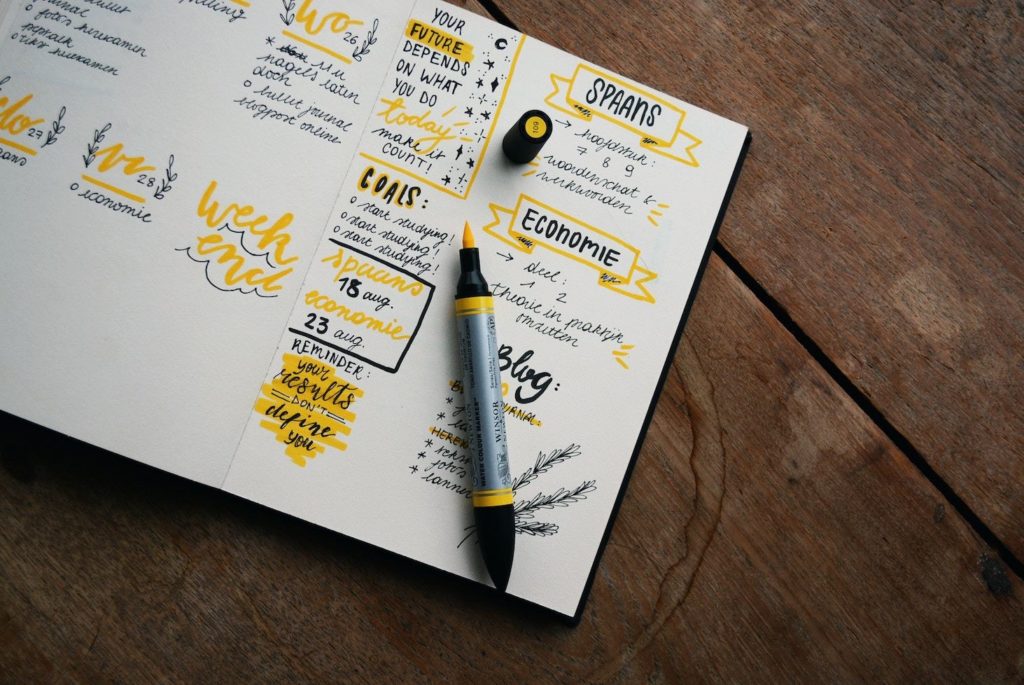Content Creation
A Freelance Writer’s Experiment in Bullet Journaling (Plus 5 Tips to Make It Work for You)
By Erin Ollila on December 13, 2017
If you're anything like me, you're desperate for organization-especially with the new year approaching. It's time to consider starting a bullet journal.
In 2017, I exclusively scheduled my life via a digital calendar and to-do list. After years of using a paper planner, I wanted to bring my life to the cloud so I could access my schedule and action items without needing to carry around a notebook wherever I went. It didn't work. For me, if something doesn't get written down, it doesn't happen. I need to be organized on paper, yet store-bought planners aren't set up how I want them to be. I was on my own to find a system that would work for me, and after extensive research, I decided to experiment with bullet journaling.
And maybe, the bullet journal system will work for you too.
Wait, What Are You Talking About?
Before I started using my journal, I asked Facebook friends for helpful suggestions for setting it up. I was hoping to see some page layouts and hear freelance writers' tips for making the experiment work for me. While I did hear a few good suggestions, I mostly heard one question repeated over and over again.
"What the heck is a bullet journal?"
I get it. When it was first suggested to me, years and years ago, I couldn't wrap my brain around the simplicity. In the most basic terms, a bullet journal, also known as a BuJo, is simply a rapid log of thoughts. It's one part diary, one part planner, and one part to-do list, all combined in one notebook. The official website calls it "a customizable and forgiving organization system. It can be your to-do list, sketchbook, notebook, and diary, but most likely, it will be all of the above. It will teach you to do more with less."
You can set it up however you like, but there are some basics to follow for anyone getting started. First, create an index in the front to list the page numbers of each spread you create for easy access. After that goes a future log, then monthly log, and finally the daily log, followed by any spread you choose to create on your own.
It's also important to have a key in the front of your journal that explains what all the symbols mean. Traditionally, a bullet is a to-do and an "x" means something has been completed. A "<" symbolizes that the item has been scheduled, while a ">" shows that it was migrated into a new list. A large circle means the item is an event, and a dash is a note.
Better yet, watch this video, created by founder Ryder Carroll to see how to they suggest each journal be set up.
Now, if this system doesn't work perfectly for you, rest assured that you can customize it however you like. For example, instead of a monthly log followed by daily logs, I decided to have a weekly spread on the left page with a running to-do list on the right. I also decided to implement writer-specific tracking pages, like a pitch planner or a deadline tracker, on a monthly basis.
But would my sudden enthusiasm for analog tracking work for me? Would I feel overwhelmed by the freedom of a blank page or my perfectionist tendencies? First, I needed to weigh the pros and cons of this type of to-do list creation.
The Advantages and Disadvantages of Bullet Journaling
The Pros
You can design your own planner. For the past few years I was using the Sugar Paper planner from Target, which they no longer carry. By embracing the bullet journaling lifestyle, I can recreate the setup I liked from my old agendas and also add specific pages most commercial paper planners do not offer to help me track other items, such as self-care, quarterly goals, and website analytics.
But I'll admit, even though going completely digital in 2017 didn't work out for me, I don't want to go completely analog with scheduling and lists. If you prefer to use a digital calendar for all of your planning needs, but still need a place for your to-do list and other habit trackers, this journal setup can be designed to meet your criteria. There are barely any rules, and, if you're like me, you'll break those rules anyway.
You can brain purge. How easy is it to write when there are stats, quotes, studies, and thoughts swimming around in your head at all time? I find it impossible. I need my environment and my brain to be clear and clean to create. When I'm backed up, uninspired, and procrastinating, it's always because I need to move thoughts from my head onto paper. Then, I'm confident to know I can follow up on those items at a later time and concentrate on what needs my attention.
Writer Lise Quintana agrees: "A lot of writers have issues like depression or anxiety, and one of the things my list does for me is it allows me to lay to rest my overwhelming fear that I'm forgetting something important or that I've let a deadline go by. When I feel stressed or overwhelmed, my first action is to start listing so that I can have a clear idea of what I need to accomplish or what my obstacles are. And I can also decide in advance what 'done' looks like, so that I can end my day and relax, confident that I've done all the things I had to do."
The Cons
You can't be a perfectionist. I'll be honest, the reason I never tried a bullet journal in the past is because I dislike my handwriting and I hate cluttering up a blank page with cross-outs and scribbles. I also love crafting, so when I binge on the hundreds of videos about bullet journaling, I want to recreate the same elaborate designs and handwritten scripts I see other journalers using. No matter how hard I try, I'm only slightly artistic and my journals would never look like theirs unless I paid someone to do it for me, which defeats the point. To really give this experiment a chance, I had to embrace the potential ugliness and keep my expectations low.
It may take a lot of time. If you're using a bullet journal as a simple thought log and don't need to create any fancy spreads, there will be little effort, as the only time you'll spend on it is listing and migrating items. However, if you're like the majority of the people who approach this analog system, you're going to want to customize it, which means an initial setup and regular maintenance of your journal.
Y'all. As a parent to two young children (a middle-schooler and a toddler-two completely different parenting extremes!) who owns and operates her business full time out of her home, I'm already begging for more time from the day. Adding a significant task, like creative journaling, to my to-do list felt overwhelming and exhausting. And also, the amount of time bullet journaling takes is the number one reason why most people I talked to refused to try it or abandoned their journal once getting it started.
My Writer-Specific Bullet Journal Experiment Setup
As I previously mentioned, it was important to me that my bullet journal works as both a paper planner and a thought collector, so I set it up prioritizing both. While I really wanted to create custom spreads and tracking logs, I didn't like the idea of mixing them up with my weekly schedulings and having to reference the index over and over again just to find everything, so I created from both the front and the back of my journal.
If you were to open the front of my bullet journal, you'll see an index (that, to be honest, never gets used), followed by my future log. Since I was experimenting, I didn't want to add the rest of 2017 and all of 2018, so I settled on the last two months of the year and the first quarter of 2018. Since I strategize my annual business goals in quarters, seeing three months on one sheet was helpful to plan strategically. In this space, I list my main priorities for the month along with important dates.
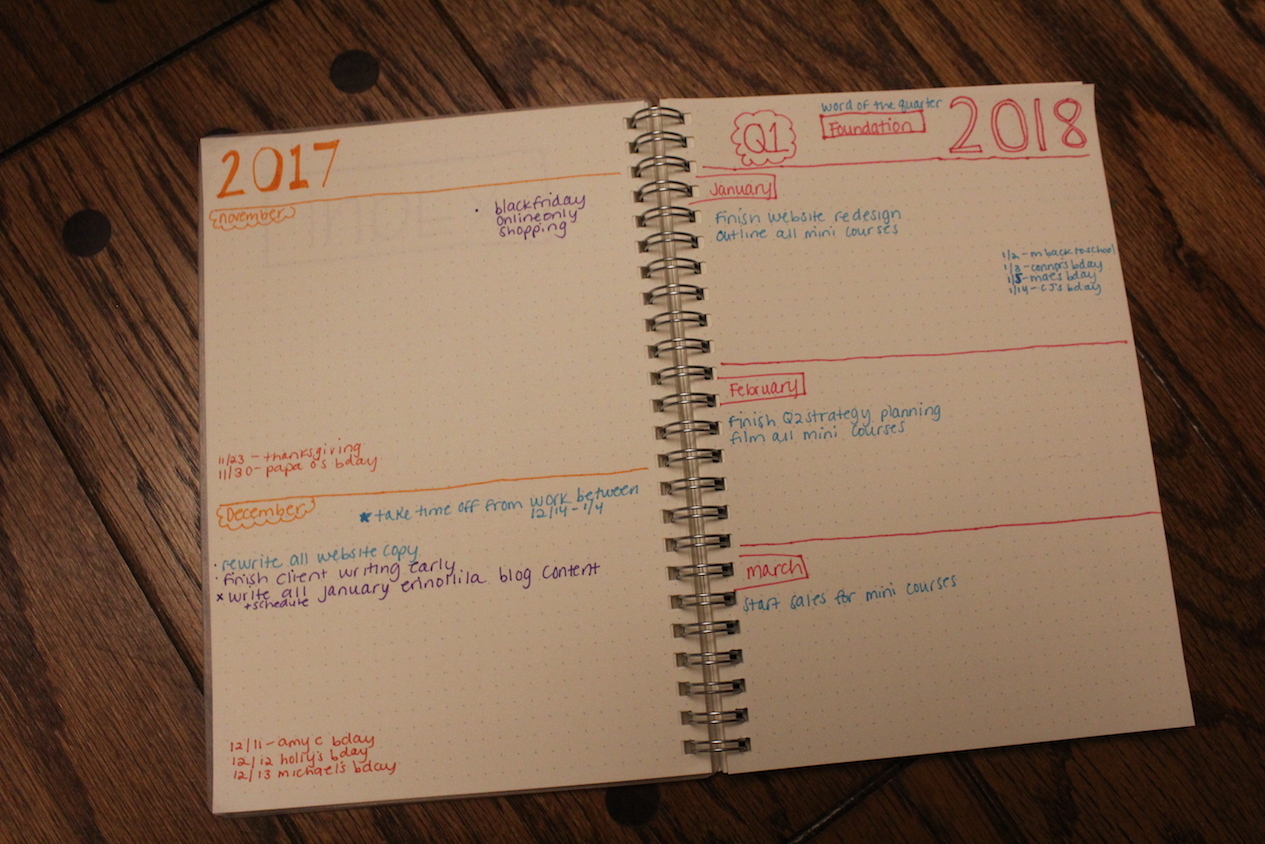
Then it's followed by the weekly scheduling and to-do list spread I mentioned above. Here, I write all of my calendar items, along with anything that comes into my mind that I need to write down, which includes anything from business goals to household supplies needed to birthday present ideas. The to-do section is probably aligned closest to the original bullet journaling exercise. If something doesn't get completed during the week it gets migrated (">") forward. I try to maintain a weekly running to do list instead of skipping a few pages ahead to schedule ("<”) items so that I can brain dump as fast as possible, which helps me with managing my ADHD thought process.
However, since I'm so accustomed to tracking on a traditional paper planner, I found myself often skipping ahead to create weekly logs so that I could jot down future tasks or ideas I wanted to focus on at a later date. I caught this "flaw" in my bullet journal system early on, and instead of trying to force myself to commit to one, I allowed my brain to work both ways. First, that meant I needed to create weekly planners for the rest of the year. Since I started in the beginning of November, it meant I needed eight full weekly spreads designed ahead of time so that I could jump ahead if needed, like a traditional calendar, while still attempting to rapid log all of my thoughts on that one weekly list.
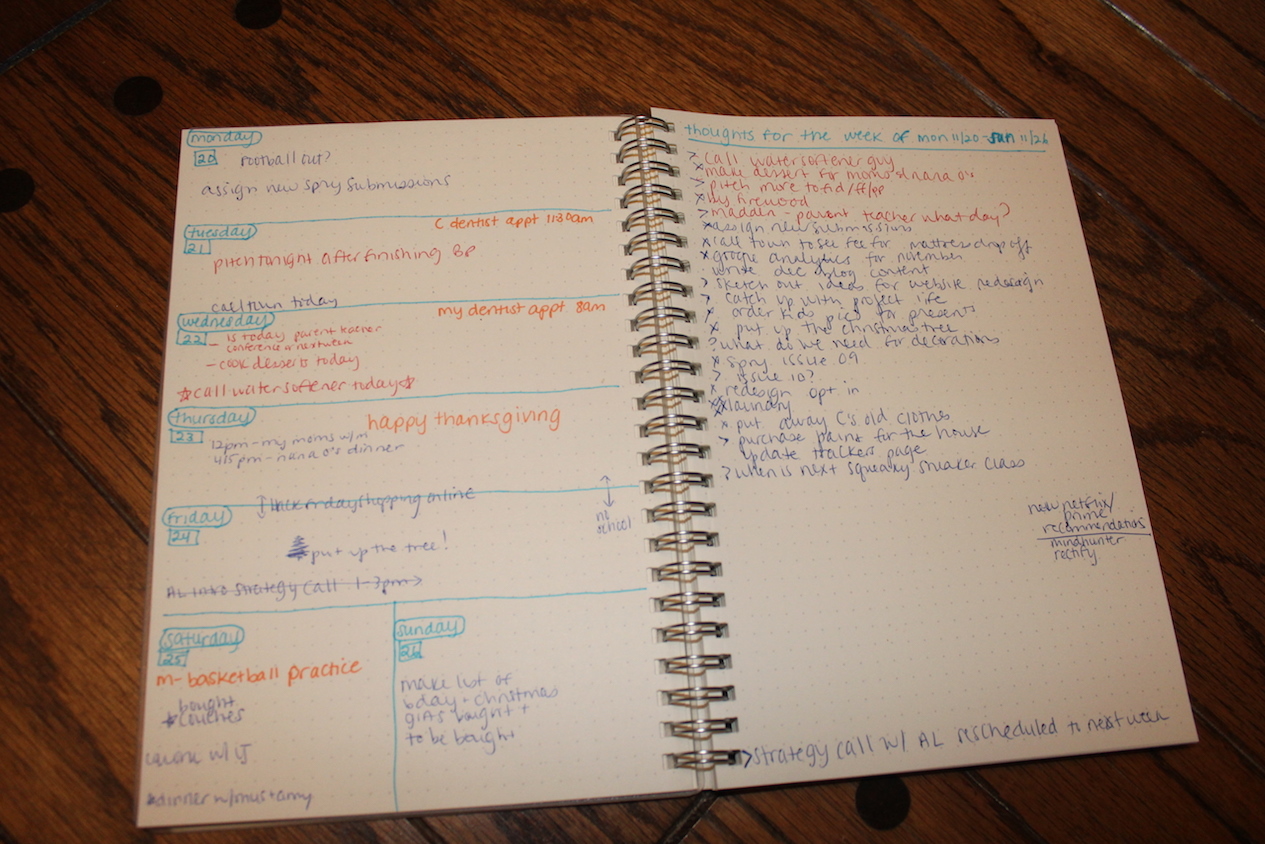
Next, starting at the back pages of my book, I created monthly trackers to keep me organized on specific goals and tasks. However, for this experiment, these trackers were complete failures on my part. Why? Probably because I put far too much thought into them and tried to do something that would work better digitally (like on a good ol' spreadsheet) in an analog way.
Take, for example, my pitch tracking sheet. What I wanted was a monthly sheet where I could jot down pitches I sent to current clients (and whether they were accepted or rejected), as well as list out dates I queried new markets. However, I barely used it. I set it up and then mostly forgot about it. It looks as if I barely pitched anything this month, when in reality I did. In the future, I'll change the spread to an idea sheet I can add to when inspiration strikes and reference when I need to send out new pitches to clients.
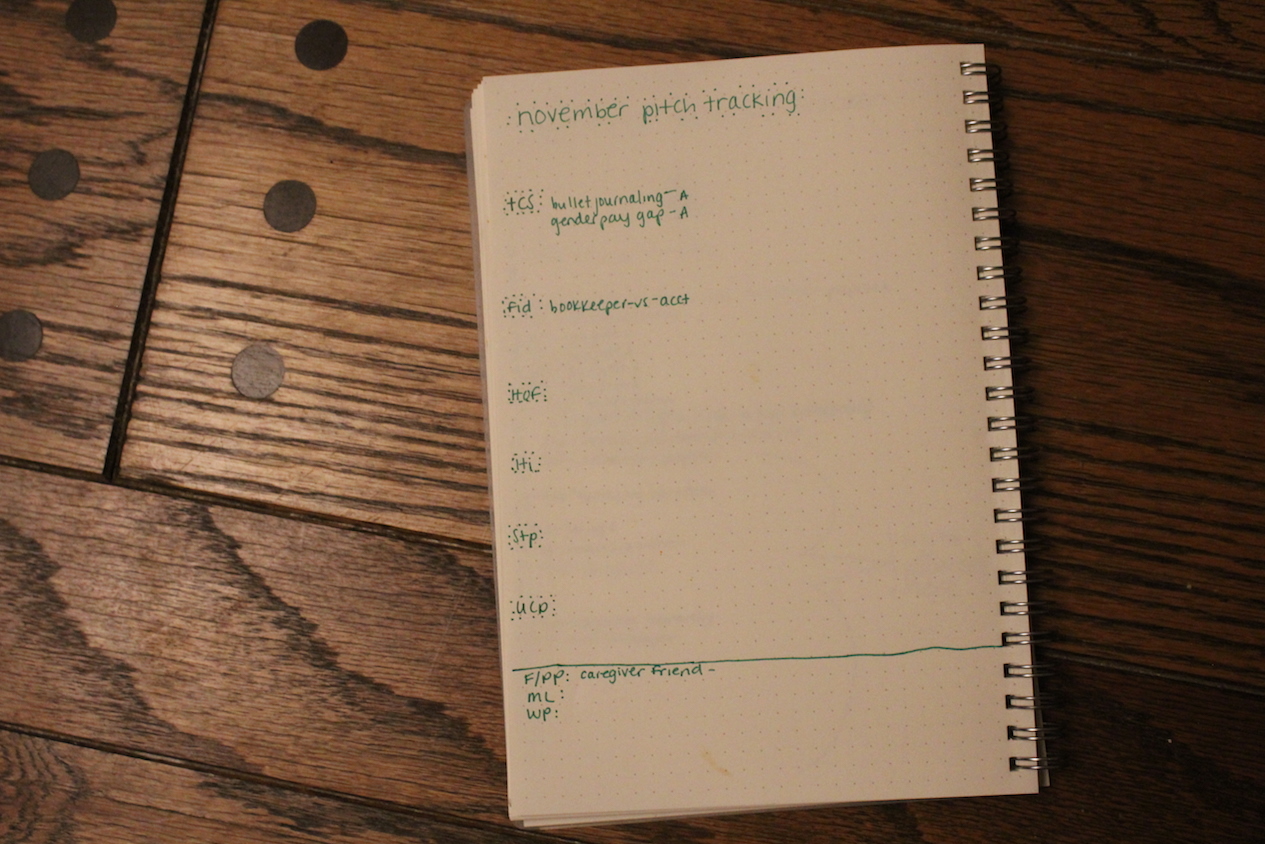
I also experienced the same issue with my self-care planner, which was one of the spreads I was most excited about. I designed the sheet carefully and put a lot of thought into what I wanted to track, yet, at the end of the month, the page was so blank-not necessarily because I wasn't taking care of myself-but because I wasn't taking the initiative to complete it. In fact, I would like to publicly commend myself for taking my vitamins at least 90 percent of the month.
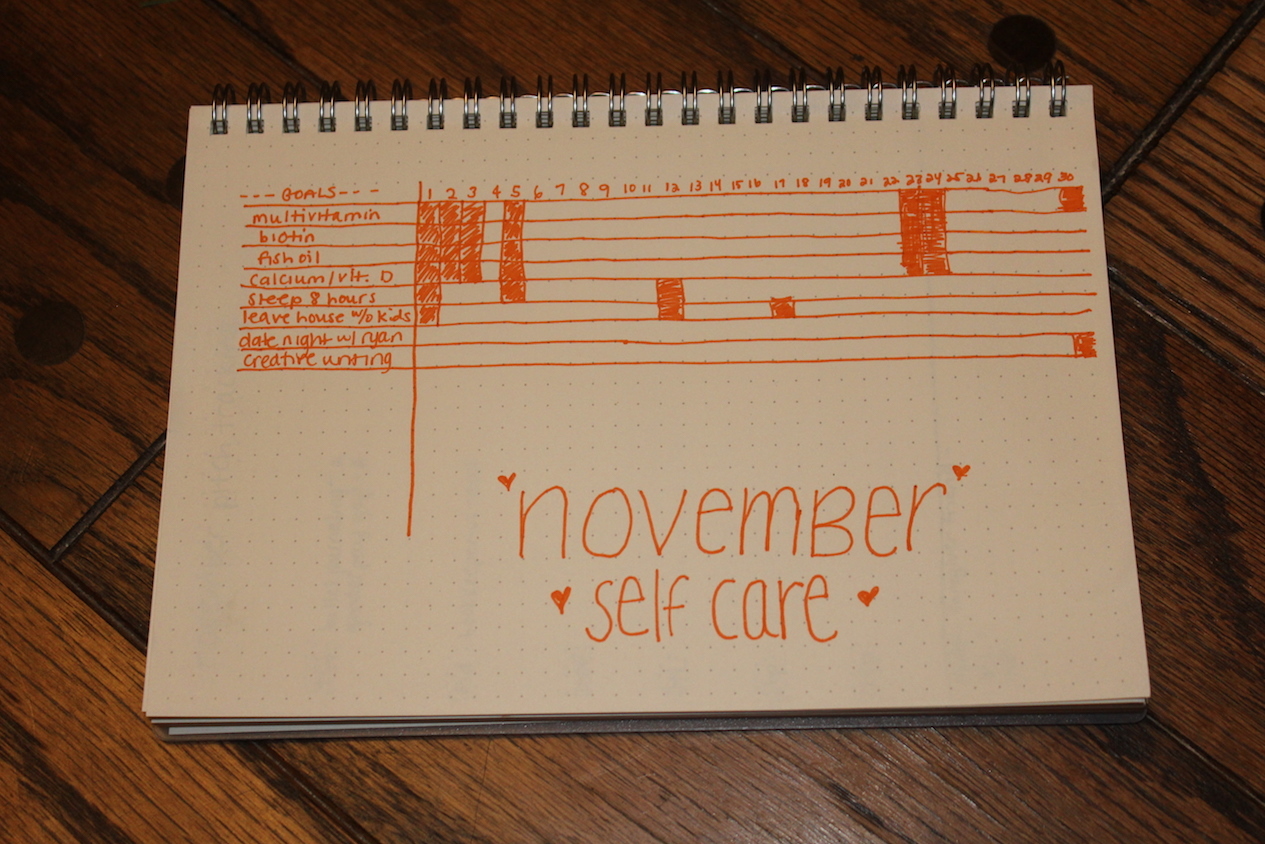
My deadline tracker had all the potential in the world. The design was simple and easy to complete. Every time I got a new deadline, I listed it with a quick content note. I even wanted to pat myself on the back for successfully completing it, but here's where I went wrong: I didn't ever reference it. Yes, I added new work in as it was assigned, but for a deadline tracker to really help a writer, one needs to continuously check it to see what's next on the horizon. This experiment taught me that deadlines need to be entered as appointments on my digital calendar with reminders set days in advance for me to pay attention to them.
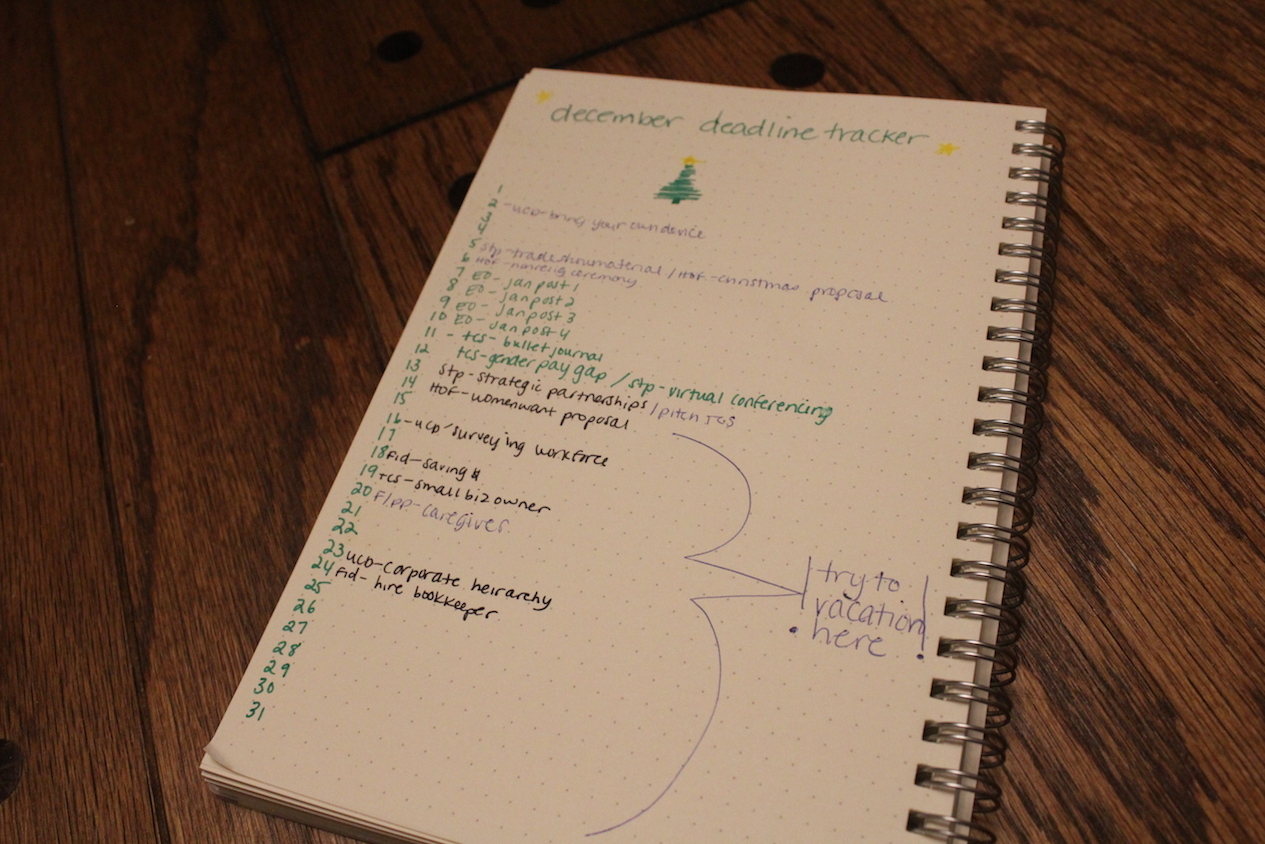
5 Bullet Journaling Tips for Freelance Writers
Develop a System That Works for You
Are you going to work on your journal daily, weekly, monthly, or all the time? What works for one person will not work for all. For example, Quintana's bullet journal is more traditional than mine. I wanted a to-do list attached to a weekly agenda with additional tracking sheets I could reference. So that I could get my journal set up how I liked it, I needed to plan for several months at a time, while also using it on a daily basis.
Quintana's journal acts as a running to-do list. She says, "Things get put into my journal in two ways: every day, I sit down at my desk and think about stuff I need to get done, and I put it into my journal. But I also have it near me while I'm working so that if the present task brings to mind another task I need to do, I can record it right away. Then, at the end of the day, I go through it and mark off what I've completed. Rather than putting a check mark (which is too small) or drawing a line through something, I have a set of eight highlighters in different colors. Every Monday, I pull out a new color so that I can tell what I've done this week as opposed to what I did in the past."
Originally, I was trying to use the same bullet key system as the website suggests, but after learning how Quintana highlights her tasks to show completion, I may start doing that in future spreads.
Decide What Goes in Your Pages
Because a bullet journal is fully customizable, you're able to include whatever you like in it. Quintana says, "I don't distinguish between household tasks, work tasks, or personal tasks, since to my mind, they're all things I need to do and since I work from home, I can do them all interchangeably. What I'm tracking is things that require my time and attention, whether it's writing another chapter, choosing submissions for my lit mag, or taking out the trash." I also use mine in the same manner.
However, I have friends that have multiple bullet journals that they upkeep at one time. One is strictly for business, another for home life, and a third for other creative goals. Now, while maintaining three notebooks seems outright overwhelming to me, they argue that my method of including everything in one stresses them out. This is a perfect example of why personalized bulleting is so important.
You do what works for you. Period.
Be Detailed
"The biggest lesson for me," says Quintana, "is a real understanding of the difference between a project and a task. Projects are made up of tasks, so if you put a project on your list, rather than all of its tasks, it sits there while you work on it, and you can't tell at a glance what stage you're at. I can't write 'Put together Issue 15,' because that's a project that takes weeks. I put 'send acceptances,' 'typeset text,' etc." Plus, who doesn't love the opportunity to cross more completed items off your list?
Being specific allows you to move quickly through each item and prioritize what's important on a daily, weekly, monthly, or quarterly basis. So, when I'm rapid bulleting on a weekly spread, I might write down "write Content Standard article." Yet, later on, I may decide to break down that project into specific daily tasks on my calendar sheets with items such as outline, research, draft, and edit.
"Another great lesson is to always record your list items as though you'll be assigning them to someone else," says Quintana, "because you might not remember what 'John, 3-4' means in a week. If you write down all the relevant information (Find out from your sister whether John turns three or four this year), future you will thank you when it comes time to do the task."
Image attribution: Tim Gouw
Choose the Right Stationary Products
I fully admit to being a paper planner elitist. I don't judge anyone else's preferences on stationary products, but I am completely picky about what I will use. This means I like a certain size notebook, and for whatever reason, it must be coiled. Most bullet journalers I follow use the popular Leuchtturm1917 journal or a Moleskin notebook. However, both are hard-spined notebooks, which don't fit my criteria. Instead, I purchased a Miliko dot-grid spiral notebook, which I like quite a bit.
To be a successful bullet journaler, Quintana thinks it's important to "keep the journal with you at all times. That means finding a size that you can write in comfortably, but also keep in a purse, pocket, or pouch." I couldn't agree with her more. If it's too small, it's difficult to use. Too big? You won't keep it with you.
And don't forget about markers, pens, highlighters, and other fun items like stickers and stencils. Depending on how crafty you want to get with your journal, you may only need a pen that you're comfortable writing with. Or you might need to invest money into calligraphy and fine-point pen makers. Here's a pro tip for you: Spend more on markers that don't bleed through the page. I purchased the Huhuhero Fineliner color pen set, but they bleed slightly, agitating my inner perfectionist.
Keep the List Current
If you're going to be a binge bulleter, you might not get the most from this system. Keeping a current notebook will help you analyze your activity, focus your brain, and become more productive and proactive with your tasks. "Remember that at the beginning of every month, you need to review last month's entries so that you can either carry them forward to the next month or decide they're no longer necessary and take off the list," says Quintana. "That's important, because it keeps your list current, which keeps it from getting overwhelming."
So, am I a die-hard bullet journaler? I'm not exactly sure. When I started this experiment, I was excited and convinced that it was exactly what I needed for an analog system. That motivation quickly waned as I felt like I had set things up incorrectly and the effort was taking too much time. Then, as I began to tweak my structure and how I used it-mostly just giving myself the permission to wing it and not follow anyone else's structure-I regained interest in it.
I'm going to attempt a 2.0 version of the experiment to take me through the first six months of the year. To do this, I'll move to the next blank page in my book and paperclip all of 2017's spreads so I can use them for reference, yet not be distracted by them. Then, I'll create future logs for the entire year, using four pages with three months on each page so that I can track my quarterly goals.
Then, I'll set up twenty-six weeks of weekly calendar sheets and to-do lists, just as I mentioned above. If I choose to include any spreads in the back of the book, they will be all lists-like books to read or people to schedule coffee chats with-and nothing for tracking. If these next six months turn out to be a failure, I'll head to my local store and pick up an academic paper planner, which conveniently starts in July.
How about you? Are you a bullet journaler? Would you consider giving it a try? Let me know your thoughts in the comments. Bonus points if you share any tips for maintaining and designing a BuJo!
For more stories like this, subscribe to the Content Standard newsletter.
Featured image attribution: Estée Janssens
